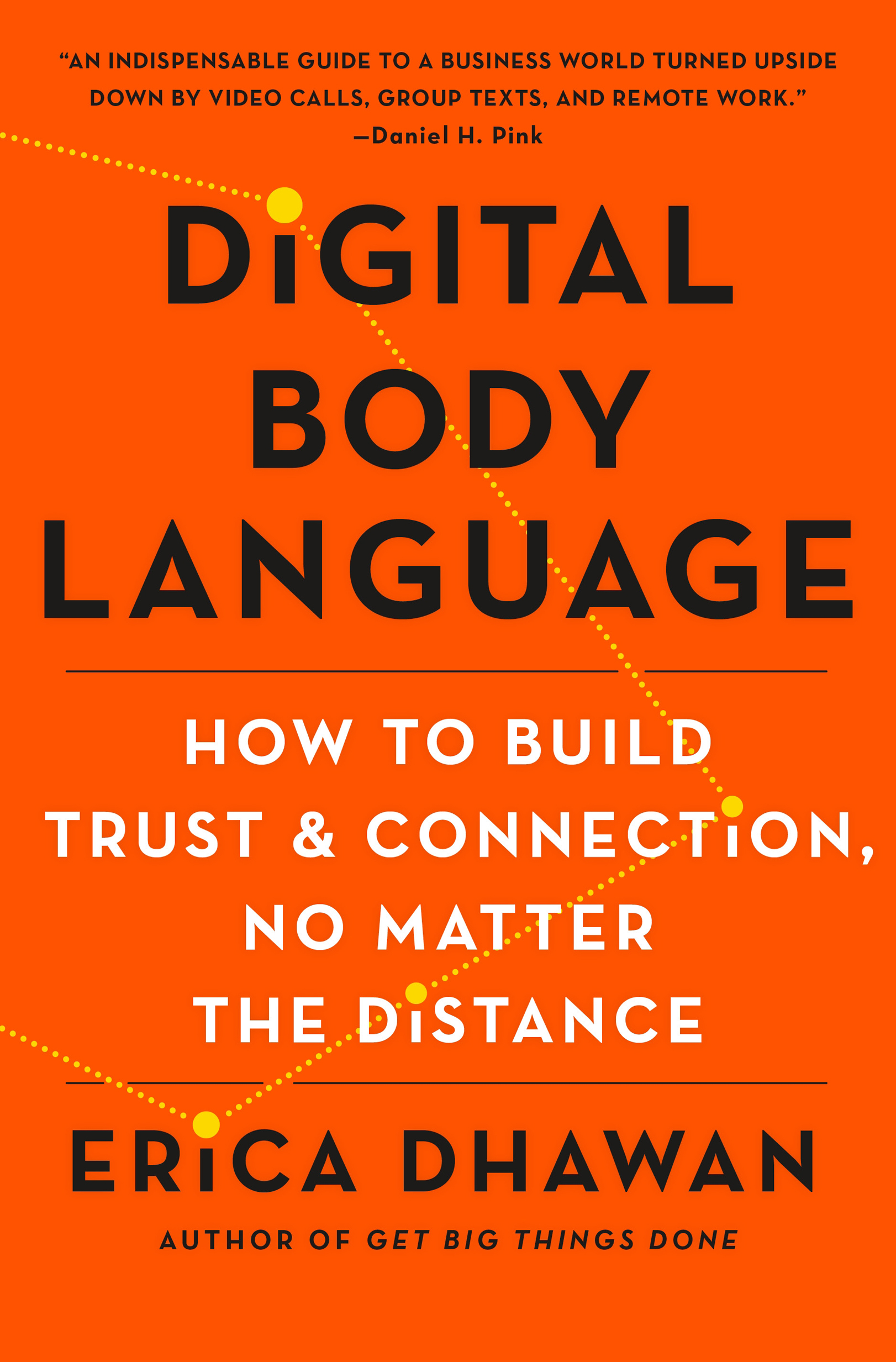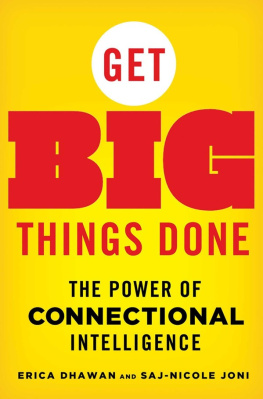Erica Dhawan - Digital Body Language: How to Build Trust and Connection, No Matter the Distance
Here you can read online Erica Dhawan - Digital Body Language: How to Build Trust and Connection, No Matter the Distance full text of the book (entire story) in english for free. Download pdf and epub, get meaning, cover and reviews about this ebook. year: 2021, publisher: St. Martins Publishing Group, genre: Home and family. Description of the work, (preface) as well as reviews are available. Best literature library LitArk.com created for fans of good reading and offers a wide selection of genres:
Romance novel
Science fiction
Adventure
Detective
Science
History
Home and family
Prose
Art
Politics
Computer
Non-fiction
Religion
Business
Children
Humor
Choose a favorite category and find really read worthwhile books. Enjoy immersion in the world of imagination, feel the emotions of the characters or learn something new for yourself, make an fascinating discovery.

- Book:Digital Body Language: How to Build Trust and Connection, No Matter the Distance
- Author:
- Publisher:St. Martins Publishing Group
- Genre:
- Year:2021
- Rating:3 / 5
- Favourites:Add to favourites
- Your mark:
- 60
- 1
- 2
- 3
- 4
- 5
Digital Body Language: How to Build Trust and Connection, No Matter the Distance: summary, description and annotation
We offer to read an annotation, description, summary or preface (depends on what the author of the book "Digital Body Language: How to Build Trust and Connection, No Matter the Distance" wrote himself). If you haven't found the necessary information about the book — write in the comments, we will try to find it.
Erica Dhawan: author's other books
Who wrote Digital Body Language: How to Build Trust and Connection, No Matter the Distance? Find out the surname, the name of the author of the book and a list of all author's works by series.
Digital Body Language: How to Build Trust and Connection, No Matter the Distance — read online for free the complete book (whole text) full work
Below is the text of the book, divided by pages. System saving the place of the last page read, allows you to conveniently read the book "Digital Body Language: How to Build Trust and Connection, No Matter the Distance" online for free, without having to search again every time where you left off. Put a bookmark, and you can go to the page where you finished reading at any time.
Font size:
Interval:
Bookmark:


The author and publisher have provided this e-book to you for your personal use only. You may not make this e-book publicly available in any way. Copyright infringement is against the law. If you believe the copy of this e-book you are reading infringes on the authors copyright, please notify the publisher at: us.macmillanusa.com/piracy.
To Kimaya and Rohan,
for inspiring me to stay forever curious.
To Rahul, for believing in me always.
After co-authoring my first book, Get Big Things Done: The Power of Connectional Intelligence, I traveled the world, speaking and consulting with companies and leaders on the challenges of twenty-first-century collaboration. My mission was to help CEOs and organizations solve the practical challenges of managing across global, multigenerational, matrixed, and virtual teams.
Everywhere I went, the same questions kept coming up: How do I keep my teams feeling connected to each other and to people on other teams? How do I help people of different ages and working styles who rarely meet in person communicate effectively? Why does it seem infinitely harder to foster trust, engagement, and the confidence to take risks? And finally, why do my own communications so often seem to miss the mark, producing unintended and anxiety-filled consequences?
The more I worked with my clients to solve these problems, the more obvious it became that they were caused by the very digital tools that had set us free in so many ways. Our failure to grapple with the communication-altering side effects of our shiny new digital toolsemail, text messaging, PowerPoint, Zoomcreated widespread misunderstanding and conflict, which in turn manifested as across-the-board anxiety, fear, distrust, and paranoia.
The good news is that our communication problems are eminently solvable with some attention to a skill I call digital body language. I have taught many leaders how to model digital body language for their teams and how to introduce it to their cultures, with remarkable results. I have trained managers, HR teams, and coaches how to embed digital body language skills into their leadership programs. And I have advised everyone from doctors using telehealth to professors using online learning platforms to lawyers, consultants, and board directors using virtual meetings how to master this skill. One leader told me that simple changes in digital body language not only transformed the communication in her entire organization but also enhanced the customer experience that she was able to provide from afar. Another executive told me it changed how he connected with his wife and children while traveling for business.
Now Ill show you how digital body language can help you.
When people ask me how I started doing what I do, I tell them its a story thats lasted my whole life.
As a first-generation American girl born to Indian parents, I came to English in an indirect way. I grew up in a middle-class neighborhood outside of Pittsburgh. At home, my parents, both physicians who had immigrated to the United States in their twenties, spoke Punjabia language close to Hindiand only rarely English. My mom and dad both made it a high priority that my two siblings and I honored traditional Indian values and customs. Silence was a sign of respect to elders, and listening a prized trait. Learning English, doing well academically, and almost everything else came in second.
Growing up in a white, conservative, suburban part of the country, I spent a lot of my childhood trying to fit in. There werent many girls who looked like me, or who were the children of immigrants, or who sat down for dinner every night at 9:00 p.m. (Indian families tend to eat late.) At the same time, I felt almost no allegiance to India. Whenever I visited, my family there referred to me as the American-born cousin. Who in India was named Erica?
Caught between two cultures, I went inside myself.
Often you would hardly know if I was in the room. In school I was shy, quiet, more an observer than a participant. Raising my hand or calling any attention to myself was unimaginable to me. I did well in school and on tests, but the comments in every report card I received from kindergarten to twelfth grade said the same thing: I wish Erica spoke up more.
As a girl pivoting between the thickly accented English of my parents and my own bad Hindi and wanting to feel like I belonged somewhere, I developed a few tricks, one of which was the ability to decipher other peoples body language. Body language offered the key to understanding the foreign worlds around me. I became obsessed with decoding my classmates signals and cues, no matter how subtle. Tone, pacing, pauses, gestures. The popular girls walked around with their heads high, shoulders pulled back, almost literally looking down on the rest of us. The older kids showed their disinterest by slouching during school assemblies, their eyes turned to the ground or each othernever to the adult speaking. At home, I holed up in my room watching Bollywood movies on my familys old VCR, focusing on the actors faces and hands instead of on the storyline (Hindi was still alien to me), rewinding over and over again, trying to understand what was being said by observing the actors nonverbal cues.
My preoccupation with translating nonverbal cues soon became a source of power as I learned to mimic the body language of my more confident peers and decode what my Hindi-speaking family members were saying to me with their furrowed brows.
After September 11, 2001, virtually everyone who looked like me in America was suddenly treated with instant suspicion in public spaces. One afternoon around that time, my father was waiting to pick me up at the local YMCA after tennis practice. Someone behind the front desk panickedmy dad looked suspicious, I guessand called the police. For the next 45 minutes, my father fielded questions from the officers, politely explaining that he worked as a cardiologist at a nearby hospital. I looked on as he sat behind a table, speaking patiently with the officershis eye contact direct, his palms wide open, signaling his respect to the officers and his understanding of why this was happening. I could also tell by his flushed cheeks that he was embarrassed. A few months later, my dad donated a significant percentage of his income that year to the 9/11 fund.
I remember being angry at the police, but also at my father. How could he respond with kindness to what I saw as racial profiling and ignorance? Patiently, my father asked my siblings and me, wouldnt it be better to consider what other people might be thinking and feeling instead of responding with indignation or rage? To put ourselves in their shoes? That was an inflection point for me, a day I began thinking harder about how humans convey empathy via body language and what it can accomplish.
My interest in nonverbal communication continued in college, where I read every book on the subject I could find; later, I called on my growing expertise professionally when I began teaching public speaking. Being able to understand and classify cues and signals, along with the poise and confidence this skill gave me, helped me win internships and, eventually, ridiculously competitive job opportunities. All of this despite my fathers insistence that Indian-Americans couldnt succeed in business and that I should instead focus on an occupation like medicine, or engineering, where Indians at least had a
Font size:
Interval:
Bookmark:
Similar books «Digital Body Language: How to Build Trust and Connection, No Matter the Distance»
Look at similar books to Digital Body Language: How to Build Trust and Connection, No Matter the Distance. We have selected literature similar in name and meaning in the hope of providing readers with more options to find new, interesting, not yet read works.
Discussion, reviews of the book Digital Body Language: How to Build Trust and Connection, No Matter the Distance and just readers' own opinions. Leave your comments, write what you think about the work, its meaning or the main characters. Specify what exactly you liked and what you didn't like, and why you think so.









